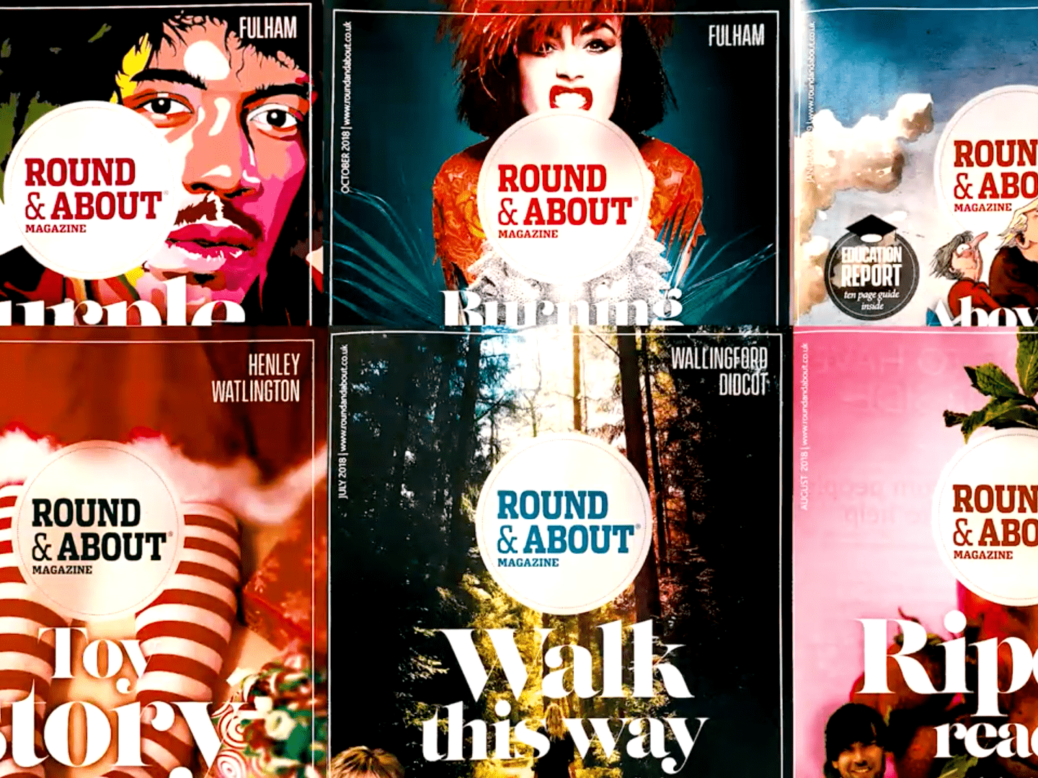
Community magazine brand Round & About is a notable rarity: a local print product boasting healthy and growing advertising revenue.
The title, which publishes 31 localised editions in six counties across the South and South West of England, says it has just experienced its best year for advertising revenues of its three decades in operation. This contrasts with other publishers, such as Mail and Metro owner DMGT and the UK’s largest commercial publisher Reach, reporting steep year-on-year declines in print advertising revenue.
Five of Round & About’s local editions were launched in the past two months, and the business now distributes 605,000 free copies a month into people’s homes.
The magazine’s managing director, Chris Savage, told Press Gazette why he believes Round & About’s delivery method, content and sales approaches are key to its success.
Like Reader’s Digest – but regionalised
Savage’s father, Peter Savage, founded the business 29 years ago this month. Today it employs 21 people.
“He worked for Reader’s Digest once upon a time, so it’s kind of where the concept came [from]”, Savage said.
The content that appears in Round & About is submitted from community members in the 31 areas in which it is distributed and then edited by the publication’s two journalists. The magazine is distributed to every home in the postcodes in which it operates by Royal Mail.
“Each edition is different,” Savage said. “There is some crossover content, but each edition has a core focus on local activities within that area – all sent in by readers.”
Round & About will publish the content it receives free of charge as long as it is not promoting a for-profit service or product. The magazines are therefore often filled with community-driven content promoting, for example, “fundraising, sports and societies, flower clubs, [retiree education charity] u3a, educational stuff, so on”, Savage said. Each month the magazines also carry a Q&A with someone notable: May’s interview is with Noel Gallagher.
Local publishing and print are both often thought of as areas of journalism that have struggled to grow revenues in recent decades. Press Gazette asked how Round & About had succeeded where other outlets have faced difficulty.
Savage said: “Something a lot of community magazines miss is the value of the content. So they’ll buy in an article about cooking from whoever, or they’ll have a crossword or Sudoku, thinking ‘okay, it’s cost of engagement’.
“But I think one of the things that’s set us apart over the years is having this relationship with the reader where they can send in any event.”
He said that generated “this kind of natural engagement with local audiences… a) if they submit something, they want to see it’s in, but b) now they’ve become so dependent on getting their message out through the magazine that if it’s not in, they’re hugely disappointed as it’s relied upon so much.”
The magazine’s revenue principally comes from advertising: Savage said it takes some sponsored submissions, but that they were cautious about paid-for content making up too much of the print product.
Savage also differentiated Round & About’s universal approach from the targeted one employed by other community magazines.
“Quite a lot of local mags try to [pick] a demographic and say ‘right, well, our demographic is A/B audience, children, private school, whatever it might be’ and try to find those homes. We’ll just go to everybody.”
Savage felt this was more appealing for local advertisers than advertising on social media.
“If you put an advert on Facebook, you get lots of stats telling you X, Y and Z. But you don’t ever see your ad, right?
“So if I’m a small local business, and I’ve got one pot of cash, and I put it onto Facebook, and [Facebook says] ‘Right, yeah, we put it in front of 20,000 local people’ – that’s great, but a) I didn’t see it, and b) I haven’t had many phone calls.”
But if an advert booked by a tradesman arrives through their own door “they also know that it’s going through the houses down the road that hopefully will buy their service”. Savage said that each month Round & About’s repeat business rate is 92%.
He also attributed some of the magazine’s success to working in-person and old-fashioned direct sales.
“I’m a big believer that everyone being back in helps the rapport amongst the team, it helps everyone to stay focused on what we’re doing, communication’s strong, which I think helps. We’re still big believers in the phone as well. So the sales team will all make sure they make their calls, rather than maybe [being] reliant on emails or different media these days.”
Like other free print products, Round & About has suffered with the rise in the price of paper. But he said prices “are coming down, so it is positive news”.
Although print is in a slow decline, it continues to provide many publishers with much of their revenue. Regional giant Reach, for example, reported digital revenue of £149.8m in 2022 versus £448.6m in print revenue.
Round & About has begun to make more investment into digital publishing: it currently averages 8,300 users a month on its website and this month it launched a dedicated app, to which 1,700 people signed up in two weeks.
“Because print’s still been so successful for us, we haven’t necessarily pushed online enough,” Savage said. Of the app, he added: “Whether that becomes the way people engage with us or it will just be a complement – we’ll see.”
Email pged@pressgazette.co.uk to point out mistakes, provide story tips or send in a letter for publication on our "Letters Page" blog
